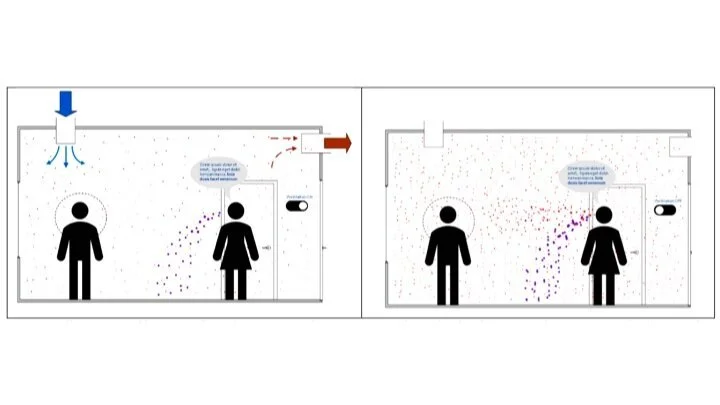Passivhaus constant draught-free ventilation
…and it should reduce Covid-19 risk!
A passive house’s mechanical ventilation heat recovery (MVHR) system should help reduce the risk of Covid-19 transmission: it’s like having windows open all the time but with no draughts and no significant heat loss.
Covid-19 mostly spreads where people are close to each other, especially in poorly ventilated indoor spaces. The UK government, which has just released a video about this, says that a fresh air supply to a room reduces the Covid-19 risk by over 70%.
And the Federation of European Heating, Ventilation and Air Conditioning Associations (REHVA) has recently updated its advice on heating, ventilation and air conditioning systems. It states that when a ventilation system is on it can reduce the concentration of virus-containing particles breathed out by an infected person.
A Passivhaus MVHR system is on all the time and provides a continuous supply of 100% fresh air throughout the house.
Why does a Passivhaus have a mechanical ventilation heat recovery system?
Most buildings tend to be ‘leaky’. There are small gaps in the roof, walls, and window and door frames that let air in and out. To some extent, this helps to ventilate the building and reduce the risk of condensation in the building’s structure leading to rot and possible structural failure.
But such ‘ventilation’ is subject to the weather, especially the strength and direction of the wind; it cannot be guaranteed or, necessarily, effective. And such gaps also cause draughts and cold spots throughout the house in the colder months.
And higher levels of insulation without adequate ventilation risk both visible condensation on cold surfaces and interstitial condensation within the building structure risking structural damage.
Airtightness is a vital part of achieving the unique passive house living experience
A Passivhaus is highly insulated and has a very high degree of airtightness. By way of comparison, air leakiness in a house built to 2013 building regulations standards has gaps the equivalent of five 20p coins per five square metres of external walling and roofing. A Passivhaus Institut-certificated building has gaps the equivalent of one 5p coin per five square metres. This is depicted in the picture below.
The gaps (leaks) in a house’s walls and roof and floor if built to 2013 building regulations standards are equivakent to five 20p coins per five square metres. In a Passivhaus this is equivalent to just a 5p coin
The gaps (leaks) in a house’s walls and roof and floor if built to 2013 building regulations standards are equivakent to five 20p coins per five square metres. In a Passivhaus this is equivalent to just a 5p coin
All-year constant fresh air without draughts and with no significant heat loss
To ensure adequate ventilation for both the building and the people in it, a passive house has an always-on ventilation system. The MVHR enables exceptionally high indoor air quality. It also ensures that water vapour in the air is kept out of the building’s fabric. It provides continuous, 100% fresh air ventilation throughout the house 24 hours a day.
The ventilation is imperceptible and draught free and, if using a Passivhaus Institut-certified MVHR unit, it can retain some 90% of the heat that would otherwise be lost. It does this by passing the outgoing air via heat exchange plates with the incoming air. The incoming and outgoing air do not mix. This is not what happens when you open a window to let fresh air into a house!
An MVHR unit requires a small amount of electricity to run. But this is substantially less energy that would be required to keep a house warm with the same level of ventilation without heat recovery. An MVHR thus also saves heating costs.
How does a Passivhaus MVHR help reduce the risk of Covid-19 transmission?
The MVHR system in a passive house is equivalent to having windows open all of the time. Government advice is to open windows regularly to flush out stale air that may contain SARS-CoV-2 virus which is the cause of Covid-19.
And the picture below, taken from the REHVA guidance on the importance of ventilation to reduce the risk of Covid-19 transmission, depicts how a ventilation system, when turned on, can reduce the number of virus-laden particles exhaled by an infected person in a room’s air. This does not eliminate the transmission risk but it should help mitigate it.
With 100% filtered fresh air continuously replacing the air in a passive house (unlike many air conditioning systems which re-circulate a high proportion of the air) we can expect the risk of Covid-19 transmission to be lower than in a non-Passivhaus.
The screen shots below are taken from the government video about the importance of ventilation to reduce the risk of Covid-19 transmission. A Passivhaus MVHR is like having a window open in every room of the house all of the time in terms of getting stale air out and fresh air in and flushing out possible Covid-19 viruses in the air.
Find out more about our MVHR system and its installation at our main blog describing our house’s construction.



